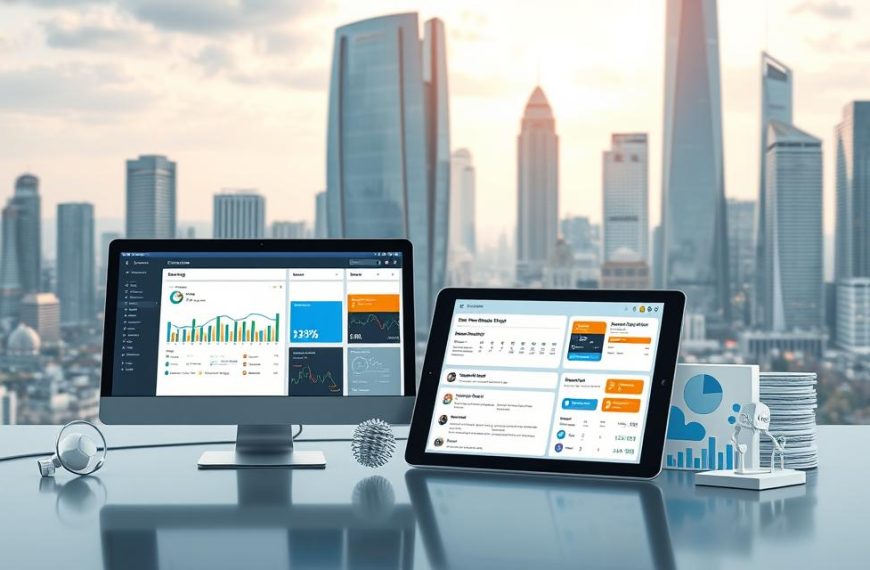Artificial intelligence is transforming the world, but its adoption varies widely across industries. Recent data from the U.S. Census Bureau reveals that only 3.8% of companies currently use this technology for production. The disparity between high-tech fields and traditional sectors is striking.
While 13.8% of information-based enterprises rely on AI, just 1.2% of hospitality businesses do. Professional and technical services fall in between, with a 9.1% adoption rate. Machine learning, natural language processing, and predictive analytics drive these applications.
The Census Bureau’s BTOS survey highlights real-world usage patterns. Many assume AI is everywhere, but the numbers tell a different story. This technology reshapes workflows, yet its impact remains uneven.
Key Takeaways:
- AI adoption stands at 3.8% among U.S. businesses
- Information sector leads with 13.8% usage
- Hospitality trails at just 1.2%
Introduction: The Expanding Reach of AI in Business
Decades of research have turned AI from sci-fi fantasy into everyday business reality. Defined as “computer systems performing human-like tasks” by the U.S. Census Bureau, these technologies now drive decision-making and efficiency.
McKinsey’s 2024 report reveals 78% of organizations use this software in at least one function.
“71% deploy generative tools regularly for core operations,”
signaling a shift from experimentation to integration.
Early machine learning models paved the way for today’s applications. Predictive analytics and natural language processing now optimize supply chains, personalize marketing, and automate customer service. This development reduces costs while boosting accuracy.
The transformative impact is clear: companies leveraging these tools outperform peers. Vertical markets from healthcare to finance race to adopt competitive advantages. What began as academic theory now reshapes global economies.
How Many Business Sectors Is AI In? The Current Landscape
Recent surveys uncover surprising gaps in digital transformation across fields. While some markets rapidly deploy advanced tools, others lag due to cost or complexity. The latest Census Bureau analysis reveals a national 3.9% adoption rate, with 6.5% of businesses planning implementation within six months.
National Adoption Rates: A Snapshot
Compared to 2019’s 3.2% baseline, growth has been steady but uneven. The Information sector leads with rates 3.6 times higher than average. Meanwhile, traditional industries struggle with infrastructure hurdles.
| Year | Adoption Rate | Planned Adoption |
|---|---|---|
| 2019 | 3.2% | N/A |
| 2023 | 3.9% | 6.5% |
Leading Industries in AI Adoption
Tech-driven sectors dominate, leveraging tools like predictive analytics. Barriers in lagging markets include limited budgets and workforce training gaps. Surveys may undercount experimental use, skewing production-level data.
As integration accelerates, disparities highlight opportunities for targeted investments. The next decade will likely see narrower gaps as solutions become more accessible.
Industries Embracing AI: Where Adoption Is Highest
Cutting-edge tools are reshaping industries, with tech leading the charge. McKinsey’s 2024 report shows 36% of IT departments now integrate these systems, while 28% of executive boards debate generative applications monthly. Investments surge as early adopters see returns.
Technology and Information Sectors
Software producers deploy machine vision for flawless QA testing. Errors drop by 40% in companies using these solutions. Data hosting providers apply NLP to resolve customer queries instantly, slashing wait times.
Key advancements include:
- Predictive analytics in finance, modeling risks with 90% accuracy
- Movie studios using algorithms to personalize content recommendations
- Consulting firms automating market research processes
Professional, Scientific, and Technical Services
These fields thrive on precision. AI-driven workflow tools cut project timelines by 30%. Legal teams use natural language processing to review contracts in minutes, not hours.
“40% of adopters now increase budgets for intelligent systems yearly,”
reflects a 2024 industry survey. The message is clear: efficiency gains justify the spend.
Sectors Lagging Behind: Where AI Use Is Minimal
Hospitality and food services show the lowest tech integration rates. Only 1.2% of these businesses currently deploy intelligent tools, with just 2.3% planning implementation. Labor-intensive workflows and thin profit margins create unique adoption barriers.
Accommodation and Food Services
Frontline activities dominate this sector, relying heavily on human interaction. A 2024 survey revealed 44% of operators reported negative outcomes from early automation tests. Manual processes like inventory tracking still consume excessive time.
| Sector | Adoption Rate | Key Barrier |
|---|---|---|
| Hospitality | 1.2% | High turnover workforce |
| Retail | 2.1% | Data fragmentation |
| Construction | 1.8% | Regulatory complexity |
Challenges in Low-Adoption Sectors
Fragmented service businesses often lack unified data systems. Small operators face compliance hurdles that deter investment. “Training costs outweigh benefits for seasonal staff,” notes a restaurant chain CFO.
Cultural resistance also plays a role. Traditional sectors prioritize hands-on expertise over algorithmic decision-making. Meanwhile, tech leaders allocate 5x more budget to digital transformation, widening the gap.
The Future of AI Adoption: Trends and Projections
Decisions now prioritize intelligent systems as workforce dynamics shift. Over the next five years, 38% of companies will retrain over 20% of their employees, per McKinsey. Meanwhile, generative tools could unlock $9 trillion annually by 2030.
Planned Use in the Next Six Months
Short-term adoption focuses on efficiency. 40% of executives already use generative tools personally, signaling top-down momentum. Emerging roles like prompt engineers and compliance specialists are redefining career paths.
| Projected Change | % of Companies | Timeframe |
|---|---|---|
| Workforce reskilling | 38% | 2024–2025 |
| Headcount reduction | 8% | Next 12 months |
| Ethics specialist hires | 300% increase | By 2026 |
Workforce Impact and Reskilling
Manufacturing faces higher displacement risks than knowledge work. Corporate programs now target legacy staff, with 5x more funding for digital training than in prior years. One CFO noted, “Retention hinges on upskilling, not replacement.”
Key developments include:
- Economic impact: Automation may affect 14% of global jobs by 2030
- Demand for AI ethics roles outpaces supply
- Consulting firms lead in real-time skills adaptation
AI’s Transformative Potential: Real-World Applications
From retail to manufacturing, intelligent systems are revolutionizing workflows. Companies report 15-25% efficiency gains in marketing alone, with tools generating text, images, and even code. These advancements reshape customer interactions and backend operations.
Marketing and Sales Breakthroughs
Brands now leverage dynamic pricing algorithms to adjust costs in real time. 63% of marketers use generative tools for content creation, while 40% of customer inquiries are handled by chatbots. Personalization engines analyze behavior to boost engagement.
Key innovations include:
- CRM enhancements that tailor recommendations based on purchase history
- Predictive analytics identifying high-value leads with 90% accuracy
- Visual recognition tools optimizing ad placements
Supply Chain and Inventory Solutions
Warehouses employ computer vision to track stock levels automatically. AI-powered logistics systems like UPS’s ORION save millions through optimized routes. Sensors predict equipment failures before they disrupt operations.
| Application | Impact | Adoption Rate |
|---|---|---|
| Predictive maintenance | Reduces downtime by 35% | 28% in manufacturing |
| Automated inventory | Cuts errors by 40% | 22% in retail |
| Route optimization | Saves $400M annually (UPS) | 18% in logistics |
These tools transform management practices across supply chains. Real-time data analysis prevents shortages while minimizing storage costs. The result? Leaner operations and happier customers.
Conclusion: The Growing Footprint of AI Across Sectors
The digital revolution continues to reshape industries at an uneven pace. While 17% of enterprises already see AI boosting profits by 5% or more, gaps persist between tech leaders and traditional players. Three-quarters of executives anticipate major disruptions within three years.
Tech-driven fields dominate adoption, but healthcare and education emerge as the next frontiers. Companies lagging behind risk losing competitive edge. Cross-functional integration is no longer optional—it’s a strategic necessity.
The impact extends beyond efficiency. Workforce reskilling, ethical frameworks, and customer expectations evolve rapidly. Leaders must act now to future-proof operations.
Prioritizing intelligent systems today ensures growth tomorrow. The time for观望 is over—build your roadmap now.













